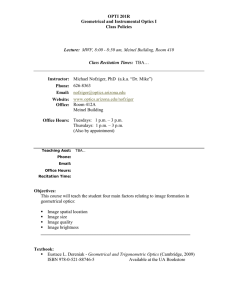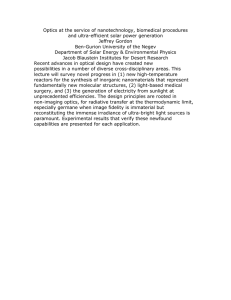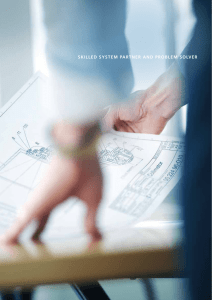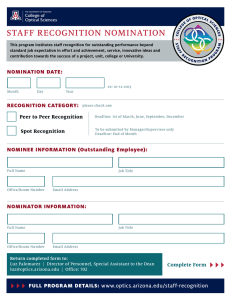OPTI 200 Light - College of Optical Sciences
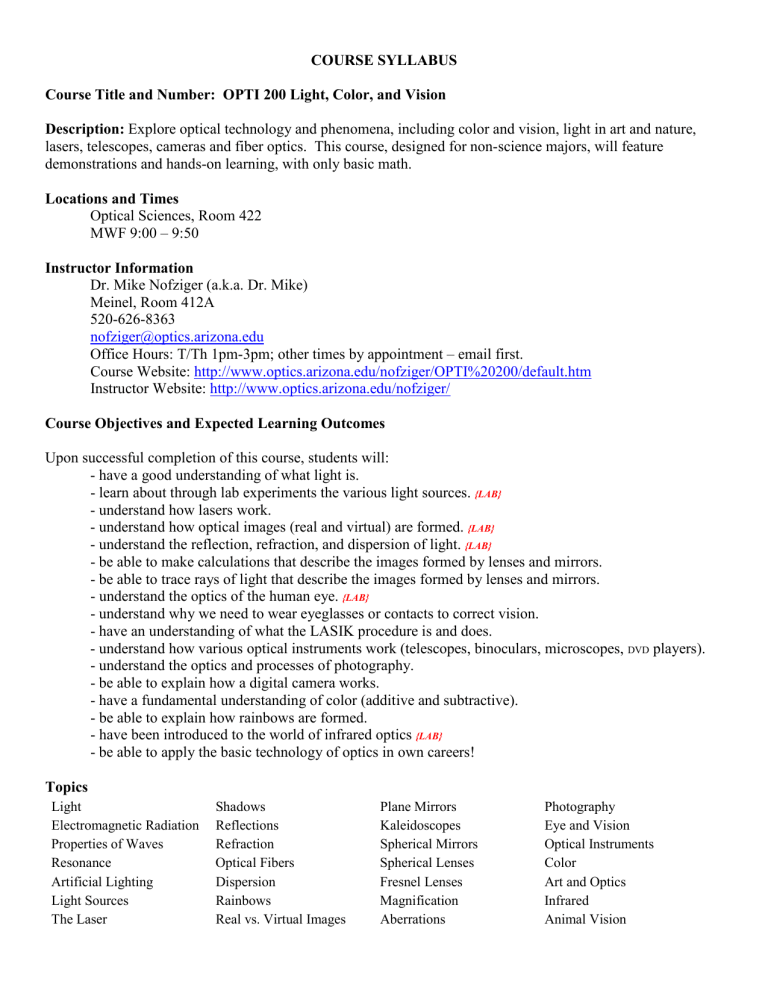
COURSE SYLLABUS
Course Title and Number: OPTI 200 Light, Color, and Vision
Description: Explore optical technology and phenomena, including color and vision, light in art and nature, lasers, telescopes, cameras and fiber optics. This course, designed for non-science majors, will feature demonstrations and hands-on learning, with only basic math.
Locations and Times
Optical Sciences, Room 422
MWF 9:00 – 9:50
Instructor Information
Dr. Mike Nofziger (a.k.a. Dr. Mike)
Meinel, Room 412A
520-626-8363 nofziger@optics.arizona.edu
Office Hours: T/Th 1pm-3pm; other times by appointment – email first.
Course Website: http://www.optics.arizona.edu/nofziger/OPTI%20200/default.htm
Instructor Website: http://www.optics.arizona.edu/nofziger/
Course Objectives and Expected Learning Outcomes
Upon successful completion of this course, students will:
- have a good understanding of what light is.
- learn about through lab experiments the various light sources.
{LAB}
- understand how lasers work.
- understand how optical images (real and virtual) are formed.
{LAB}
- understand the reflection, refraction, and dispersion of light.
{LAB}
- be able to make calculations that describe the images formed by lenses and mirrors.
- be able to trace rays of light that describe the images formed by lenses and mirrors.
- understand the optics of the human eye.
{LAB}
- understand why we need to wear eyeglasses or contacts to correct vision.
- have an understanding of what the LASIK procedure is and does.
- understand how various optical instruments work (telescopes, binoculars, microscopes,
DVD
players).
- understand the optics and processes of photography.
- be able to explain how a digital camera works.
- have a fundamental understanding of color (additive and subtractive).
Topics
- be able to explain how rainbows are formed.
- have been introduced to the world of infrared optics
{LAB}
- be able to apply the basic technology of optics in own careers!
Light Shadows
Electromagnetic Radiation Reflections
Properties of Waves
Resonance
Refraction
Optical Fibers
Artificial Lighting
Light Sources
The Laser
Dispersion
Rainbows
Real vs. Virtual Images
Plane Mirrors
Kaleidoscopes
Spherical Mirrors
Spherical Lenses
Fresnel Lenses
Magnification
Aberrations
Photography
Eye and Vision
Optical Instruments
Color
Art and Optics
Infrared
Animal Vision
Course Methodology
Generally curriculum-centered with content presentations and lectures
Some constructivism with group lab exploration and journal discussion
Teaching Format
Lecture and lab combination
Required Texts
Seeing the Light: Optics in Nature, Photography, Color Vision and Holography, (Falk, Brill, and Stork)
Hardcover, 480 pages, © 1986, Publisher: John Wiley & Sons Inc. ISBN: 0471603856
Available for purchase at the UA Bookstore
Optics Made Clear: The nature of light and how we use it, (William L. Wolfe, Professor Emeritus,
Optical Sciences Center)
Paperback, 264 pages, © 2007, Publisher: SPIE Press ISBN: 0819463078
Available for purchase at the UA Bookstore
Required or Special Materials
Notebook or binder for lab and activity notes
Journal notebook
Calculator, Graph Paper (free online at: Print Free Graph Paper and Incompetech )
Required/Recommended Knowledge
Basic Math
(Any student who has successfully completed the Math Foundations requirement is prepared for the math used in OPTI 200. The only math we use is the solution of simple, linear, algebraic equations, and y vs. x data-plotting.)
Grading Policy
Homework
Lab: Notebook and Activities
Research Paper
(Rough Draft) 15%
(Final Draft) 10%
Journal Writing
Midterm Exam (in-class)
Final Exam (in-class)
20%
20%
25%
10%
10%
10%
Unannounced Quizzes 5%
Final grades will be calculated on a 'curve' for the entire class.
Late Work Policy Homework will be accepted late (up to a week after it was due), but will be graded at
50% off.
Attendance Policy
It is important to attend all classes, as what is discussed in class is pertinent to adequate performance on assignments and exams. If you must be absent, it is your responsibility to obtain and review the information you missed.
Unannounced quizzes will be given to encourage attendance, and to help you gauge your progress in learning the material.
If you miss the midterm or final exams, they may not be made up unless you have a documented medical or family emergency. Quizzes may not be made up for any reason.
"All holidays or special events observed by organized religions will be honored for those students who show affiliation with that particular religion. Absences pre-approved by the UA Dean of Students (or
Dean's designee) will be honored."
Classroom Behavior
The Arizona Board of Regents’ Student Code of Conduct, ABOR Policy 5-308, prohibits threats of physical harm to any member of the University community, including to one’s self. See: http://policy.web.arizona.edu/~policy/threatening.pdf.
Special Needs and Accommodations Statement
Students who need special accommodation or services should contact the Disability Resources Center,
1224 East Lowell Street, Tucson, AZ 85721, (520) 621-3268, FAX (520) 621-9423, email: uadrc@email.arizona.edu, http://drc.arizona.edu/. You must register and request that the Center or DRC send me official notification of your accommodations needs as soon as possible. Please plan to meet with me by appointment or during office hours to discuss accommodations and how my course requirements and activities may impact your ability to fully participate. The need for accommodations must be documented by the appropriate office.
Student Code of Academic Integrity
Students are encouraged to share intellectual views and discuss freely the principles and applications of course materials. However, graded work/exercises must be the product of independent effort unless otherwise instructed. Students are expected to adhere to the UA Code of Academic Integrity as described in the UA General Catalog. See: http://deanofstudents.arizona.edu/codeofacademicintegrity
Confidentiality of Student Records http://www.registrar.arizona.edu/ferpa/default.htm
Subject to Change Statement
Information contained in the course syllabus, other than the grade and absence policy, may be subject to change with advance notice, as deemed appropriate by the instructor.
Writing Requirements
Research paper: rough draft (15% of the overall course grade)
The requirement is a 10-page paper, double-spaced, with at least 5 references. I grade these for length, spelling, grammar, technical content, and the clarity and quality of the writing. My grading includes specific corrections and indications of where some aspect of the paper needs to be improved (leaving it up to the student to make their own decisions as to ‘how’ to make the correction).
Research paper: final copy. (10% of the overall course grade)
The student is expected to correct and revise their rough draft, which I grade a second time. My grading of the final copy is specific to whether or not they have made changes to, and improved on, their rough draft. http://www.optics.arizona.edu/nofziger/OPTI%20200/Course%20Shell/RP200.htm
Lab Notebook (20% of the overall course grade)
The course includes a number of lab exercises / activities that we do during normal class time (in our sophomore optics teaching lab). You are expected to keep a lab notebook, writing down your observations, data, etc. during these labs. I will give you handouts which ask you to make both general and specific written observations, to record numerical data, and to answer specific questions. Part of these activities include basic calculations and data plotting.
As an example, one of the assignments, after we have studied various light sources in the lab, is to go out into the world to observe and write about various light sources that they encounter. Your writing assignment is to describe the physical and spectral nature of each light source. http://www.optics.arizona.edu/nofziger/OPTI%20200/Homework/LA1.htm
Journal Writing (10% of the overall course grade)
You will be required to maintain a personal journal, making written entries on specific topics relevant to our course of study. The topics are only intended to provide a starting point—their actual writing, content, style, approach, and specifics are totally open-ended. This allows for creative writing, scientific writing, poetry, etc. Topics will change from semester to semester, but recent topics from the course have included:
‘infinity’, ‘luminous’, ‘shadows’, ‘color’, and ‘reflection.’
I keep my own journal, and we devote class time to sharing our journal entries.
Miscellaneous Writing Assignments
One assignment I always make in this course is to have you go to the Center for Creative Photography, and make observations of the current photography exhibit. You are asked to write a half-page on each of 3 photographs, 2 from the current exhibition, and 1 from the permanent display of Ansel Adams photographs. To relate to topics we’ve discussed in class, you are required to observe and discuss the use of light and shadows, as well as the resolution (details) in the photos. http://www.optics.arizona.edu/nofziger/OPTI%20200/Homework/WA2.htm
Honors Students
Students taking the course for Honors credit are required to include the following in their Honors contract for this course:
Required Honors Assignments:
For OPTI 200, the following activities will be required of all Honors students, assigned as part of their individualized Honors Contract:
- Give a 15minute presentation (“mini-lecture”) to the entire OPTI 200 class on your own selected topic of interest in optics. This can include:
- any topic in optics that interests you, of your choice. Research it to include 10 references, 5 from professionally-published papers. Use Power Point slides, with graphics and scientific data, to teach the class about this topic.
….. or …..
- If you are working in a campus lab or in a local company (in a science or engineering field), present your work in a 15-minute mini-lecture to the OPTI 200 class. Relate it to some aspect of optics. Use Power Point slides, with graphics and scientific data, to teach the class the basics of your work and how it relates to light and optics.
- All of the required lab work that everyone does.
- All of the homework that everyone does.
- The 10-page research paper (rough draft and final copy) that everyone does.
- All of the journal writing.
- The midterm and final exam.
Optional Honors Assignments (pick one):
For OPTI 200, the following activities are available to Honors students. Pick one, to be assigned as part of your individualized Honors Contract:
- Attend 6 of our Friday Community Speakers Lectures (optics undergraduate and graduate students present their research every Friday at noon). Write a 1-page summary of each lecture, including the relevance and real-world application of the optics involved.
- Meet with 3 members of our faculty to learn about their research. Write a 2-page summary of each meeting, including the relevance and real-world application of the optics involved.
- Visit 3 of our research labs to interact with our students doing research. Interview each student about the work they are doing. Read a published paper from each lab that pertains to the research they are doing. Write a 2-page summary of each meeting, including connections to the published paper. Discuss the relevance and real-world application of the optics involved.
- Customize your own assignment, per the approval of the instructor.
Assignment Schedule and Due Dates see current on-line schedule at: http://fp.optics.arizona.edu/Nofziger/OPTI%20200/Course%20Shell/Syllabus%20F12.htm
